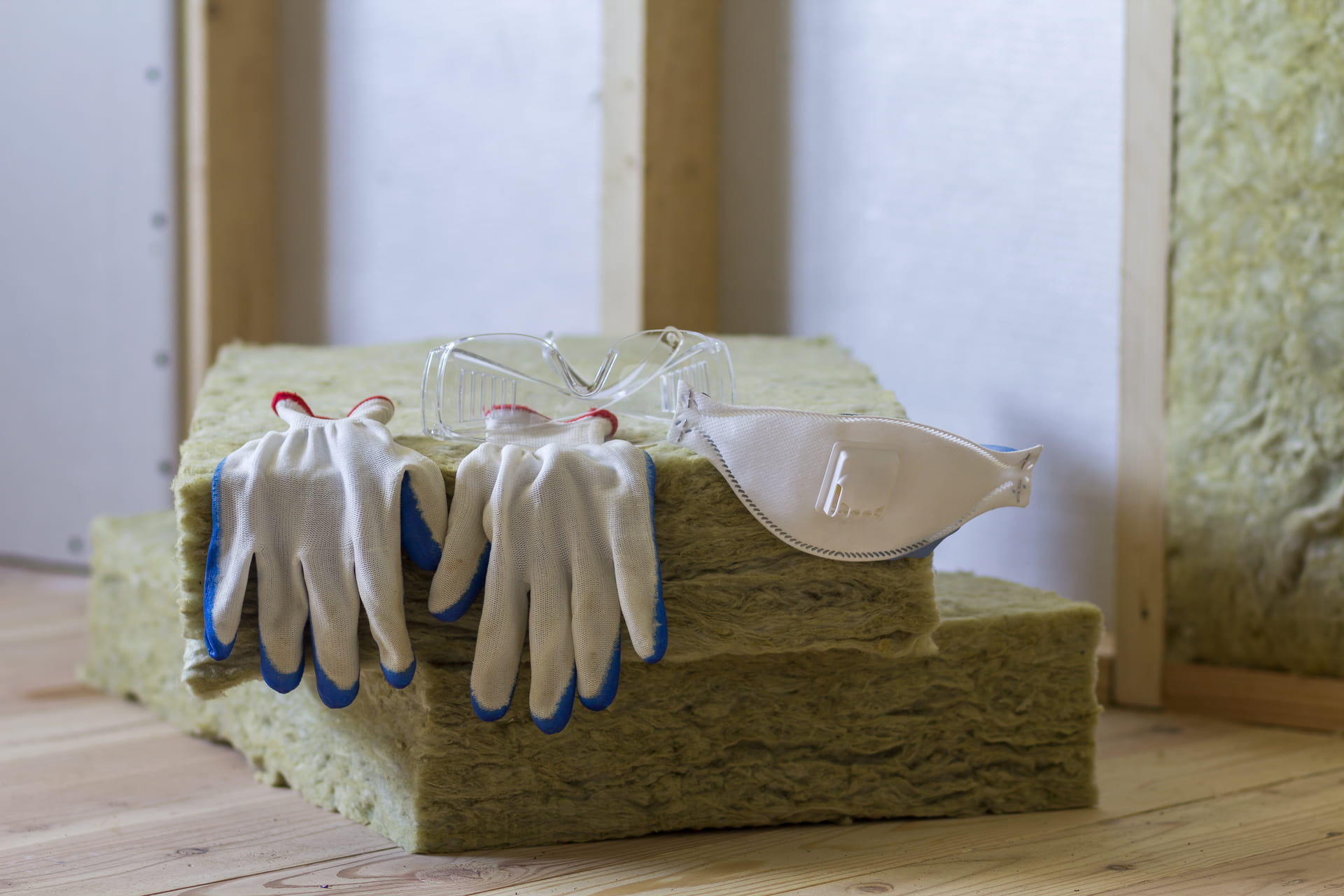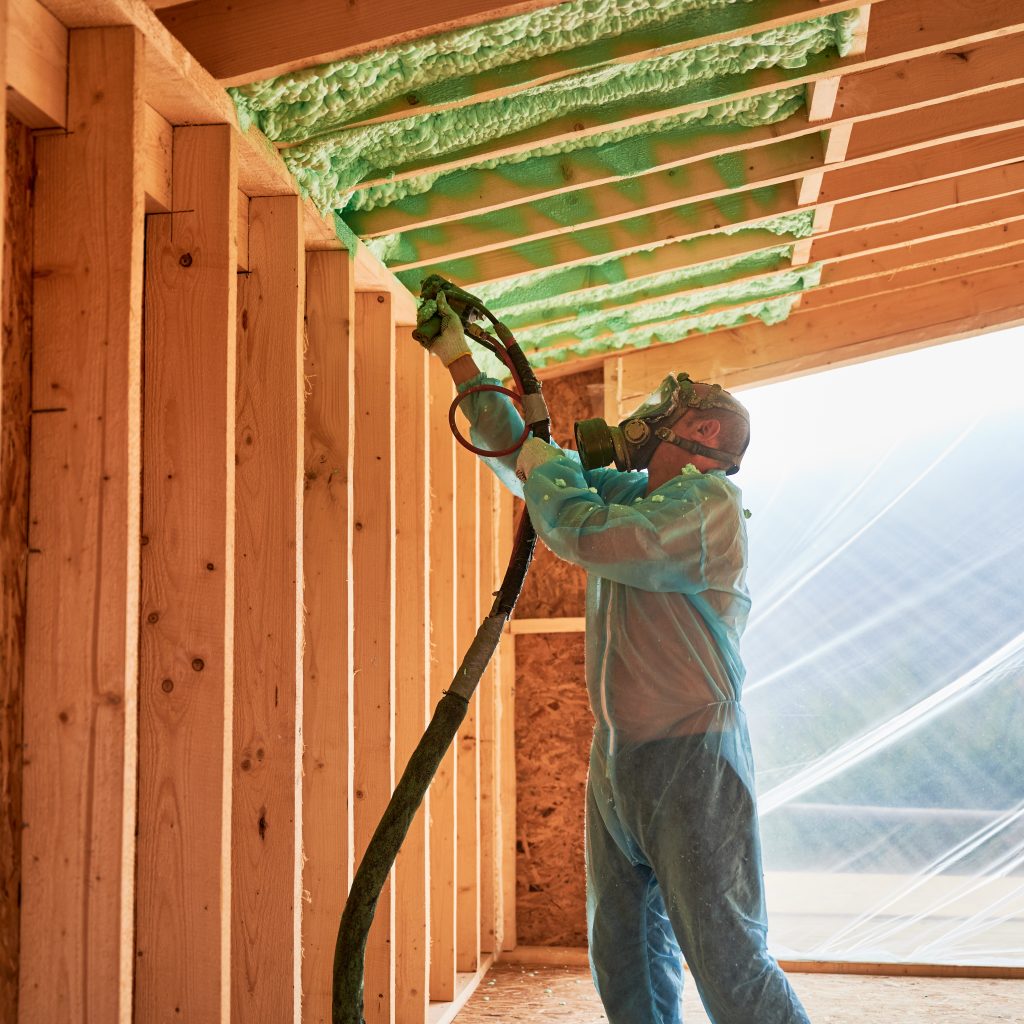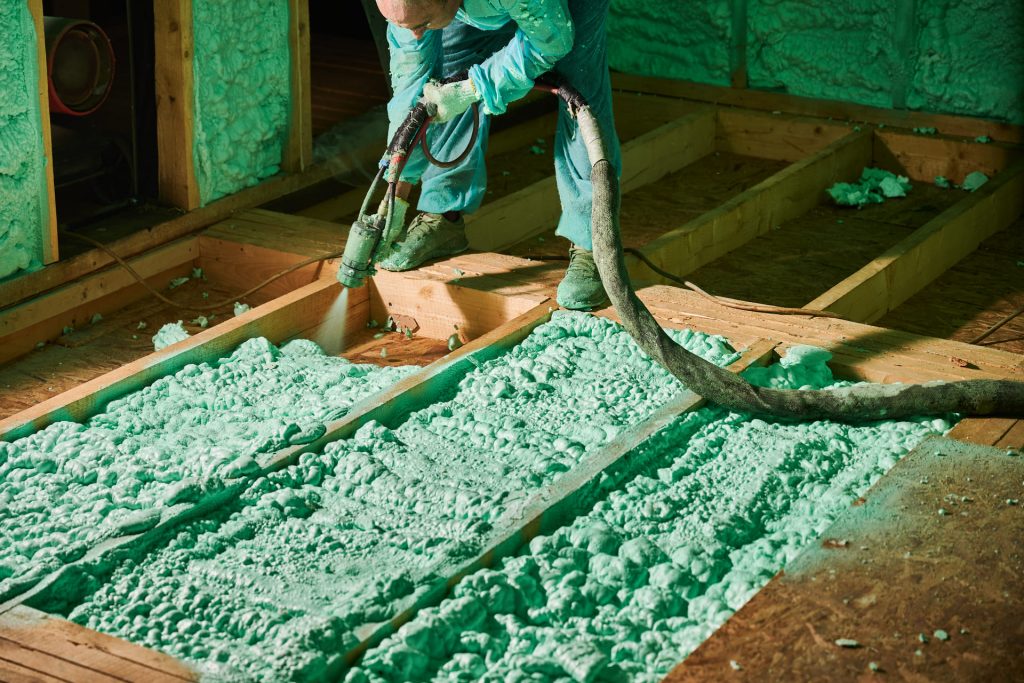
Choosing the best materials to insulate your home starts with knowing the different types of insulation for homes. From spray foam and fiberglass batts to mineral wool and rigid foam boards, each option brings its own strengths. The right choice depends on your house, climate, budget, and energy goals.
Some materials work better for attics or crawl spaces, while others are ideal for walls or basements. Air sealing, moisture control, and thermal resistance all play a role. In the sections below, we break down key options and help you decide which solution fits your home’s needs best.
How many types of insulation are there?
There are five main home insulation types used in residential construction today: fiberglass insulation, cellulose insulation, mineral wool insulation, spray foam, and reflective insulation. Each type offers different benefits based on cost, performance, and application, especially when factoring in your home’s design and local climate conditions.
Fiberglass insulation, one of the most commonly used materials, is made from fine glass fibers and performs well when properly installed, particularly in attics and wall cavities. Cellulose insulation is made from recycled paper or recycled paper products, and it is effective at reducing airflow by filling gaps in older or new construction homes.
Mineral wool insulation—also known as rock wool—has a naturally high R-value, making it a top choice for cold climates. It also provides good air quality performance and moisture resistance. Reflective insulation, on the other hand, works by bouncing heat away, helping with cooling costs in warmer areas.
Choosing the right insulation depends on your needs for energy savings, indoor comfort, and building layout. A well-chosen insulation system improves energy efficiency, lowers heating and cooling demands, and can significantly reduce monthly energy bills.
With this in mind, if you want to get us to quote you for your roof replacement and are in Wisconsin, get in touch with us!
Types of insulation material
When evaluating what types of insulation are available, it helps to understand the full range of home insulation options available. Each material has unique properties that affect cost, installation, energy savings, fire resistance, and long-term performance.
Some are better for existing homes, others for new construction, and many can boost energy efficiency and comfort when combined with insulation and air sealing techniques.
Below, we break down the most commonly used types of insulation to help you make an informed decision.
1. Fiberglass

This type of insulation is one of the most commonly used types of insulation in existing homes and new construction. But, what is it made from? Fiberglass insulation is made from spun glass fibers and is available in batts, rolls, and loose-fill. It offers good thermal performance with an average R-value per inch of 2.9 to 3.8.
- Fire resistance: Naturally fire-resistant, does not burn easily.
- Cost: Relatively low, making it a popular insulation choice.
- Thermal efficiency: Offers reliable thermal and acoustic performance.
- Installation: DIY-friendly, but handling fiberglass requires protective gear.
- Sound insulation: Moderate effectiveness in reducing sound transmission.
- Environmental impact: May contain recycled glass, but not biodegradable.
2. Mineral Wool (Rock Wool or Slag Wool)

Made from molten rock or industrial slag, mineral wool insulation is known for its fire resistance and thermal properties. It comes in batts and loose-fill forms.
- Fire resistance: Excellent—can withstand very high temperatures.
- Cost: Slightly higher than fiberglass but affordable.
- Thermal efficiency (R rating): Higher R-value per inch (typically 3.0–3.3).
- Installation: Can be DIY-installed but requires gloves and a mask.
- Sound insulation: Excellent at dampening noise.
- Environmental impact: Often contains recycled materials, non-biodegradable.
3. Cellulose
Cellulose insulation is made from recycled paper or recycled paper products, treated with fire retardants. It is usually blown into attics or existing walls.
- Fire resistance: Fair, with added retardants to improve safety.
- Cost: Moderate, cost-effective for retrofits.
- Thermal efficiency: High R-value (3.2–3.8 per inch).
- Installation: Typically requires professionals with special equipment.
- Sound insulation: Good at soundproofing, filling gaps effectively.
- Environmental impact: Very eco-friendly; made from recycled paper.
4. Spray Foam (Polyurethane or Soy-based)

Applied as a liquid that expands into foam, spray foam can be used to insulate walls, ceilings, and floors. It forms an air-tight seal.
- Fire resistance: Needs a thermal barrier; not naturally fire-resistant.
- Cost: High—tends to be more expensive than other types.
- Thermal efficiency: High R-value per inch (up to 6.5).
- Installation: Requires professional installation.
- Sound insulation: Excellent for both thermal and acoustic sealing.
- Environmental impact: Some versions use eco-friendlier blowing agents.
HIGH-PERFORMANCE HOME INSULATION YOU CAN RELY ON
Chose Prairie Exteriors for reliable, energy-efficient insulation built to last.
5. Rigid Foam Boards
Foam board insulation consists of polystyrene, polyisocyanurate, or polyurethane. Used for walls, roofs, and foundations.
- Fire resistance: Varies—some types need fire barriers.
- Cost: Moderate to high, depending on type.
- Thermal efficiency: Excellent; offers high R-values per inch.
- Installation: Requires cutting tools and sealing around gaps.
- Sound insulation: Moderate when sealed properly.
- Environmental impact: Long-lasting but not biodegradable.
6. Cotton/Denim
This insulation is made from recycled cotton fabrics, often old denim jeans.
- Fire resistance: Treated to resist fire.
- Cost: Higher than fiberglass, but still reasonable.
- Thermal efficiency: R-value of 3.0–3.7 per inch.
- Installation: DIY-friendly; safe to handle.
- Sound insulation: Excellent.
- Environmental impact: Made from recycled fibers; very eco-conscious.
7. Sheep’s Wool
Natural wool insulation provides moisture control and thermal comfort.
- Fire resistance: Naturally fire-resistant due to lanolin.
- Cost: High, due to material and sourcing.
- Thermal efficiency: Around R-3.5 per inch.
- Installation: Can be installed by hand; very safe.
- Sound insulation: Very good for acoustic comfort.
- Environmental impact: Fully biodegradable and renewable.
8. Aerogel
This modern insulation is made from silica-based materials, with a light and porous structure that insulates extremely well.
- Fire resistance: High.
- Cost: Very expensive.
- Thermal efficiency: Highest known R-value per inch.
- Installation: Requires professional tools and expertise.
- Sound insulation: Moderate.
- Environmental impact: Synthetic, but very long-lasting.
9. Aluminum-Faced Products
Reflective insulation works by reflecting radiant heat. It’s commonly used in attics and hot climates where the primary concern is heat gain.
- Fire resistance: Good when paired with other layers.
- Cost: Low to moderate.
- Thermal efficiency: Lower R-value but effective at reducing heat.
- Installation: Easy to install on unfinished attic floors.
- Sound insulation: Minimal.
- Environmental impact: Recyclable; often made with minimal materials.
10. Legacy or Specialty Materials
This category includes older, uncommon, or emerging insulation products. While they may not be as widely used as fiberglass or spray foam, they each have specific use cases in residential or sustainable construction.
- Perlite: A loose-fill mineral often used in masonry walls. Lightweight and fire-resistant, but has a lower R-value per inch compared to modern products.
- Vermiculite: Similar to perlite but softer. Historically used in attics and wall cavities, though some older batches may contain asbestos.
- Cementitious Foam: A non-toxic, water-based mineral foam that expands in place and hardens. Fire-resistant and ideal for filling wall cavities, but brittle and not widely available.
- Phenolic Foam: A rigid board insulation with strong fire and thermal performance. It has a high R-value but tends to be brittle and prone to shrinkage.
- Urea-Formaldehyde Foam: Once used in the 1970s for cavity wall insulation. It’s no longer recommended due to off-gassing and degradation issues.
- Straw Bale Insulation: A natural, renewable method using compacted straw within wall systems. Offers excellent thermal resistance but requires thick walls and moisture protection.
- Hempcrete: Made from hemp fibers and lime, it insulates, regulates humidity, and is mold-resistant. Best suited for eco-conscious builds.
- Expanded Cork: A natural, sound-dampening insulator that’s fully recyclable and renewable. Performs well in thermal and acoustic insulation, but is more expensive.
- Mycelium Insulation: A fungal-based material that’s biodegradable and fire-resistant. Still experimental but promising in green construction.
- Vacuum Insulated Panels (VIPs): Thin, high-performance panels with an extremely high R-value. Great for space-constrained applications, but costly and fragile.
- Aerated Concrete Panels: Lightweight blocks with insulating air pockets, sometimes used in passive home designs.
- Recycled Denim or Cotton Blends: While already listed separately, hybrid versions incorporating other recycled fibers may be used for specialty purposes, depending on the manufacturing process.
Not Sure Which Insulation Is Right for Your Home? Speak with our local experts to find the best material based on your budget, climate, and goals..
What are the different types of insulation for houses? 7 insulation methods
The kinds of insulation available for houses vary not only by material, but also by method—how that material is installed and where it’s applied. Choosing the right method impacts everything from air sealing to energy savings and long-term performance.
Below are the most common insulation methods used in homes today, with key details about where they work best, what they cost, and how they’re applied.
1. Batt and Roll Insulation

This type of insulation involves large pre-cut sections (batts) or rolled blankets of material—usually fiberglass, mineral wool, or cotton. It is designed to fit snugly between wall studs, ceiling joists, and floor beams. Batts are available in standard sizes to match framing, and are usually backed with paper or foil for added moisture control.
- Common uses: Walls, attics, floors, and ceilings in both new construction and retrofit projects.
- Materials: Fiberglass, mineral wool, and natural fibers like cotton.
- Air sealing: Limited—gaps can remain if batts are poorly installed.
- DIY-friendly: Yes, though proper safety equipment is necessary due to fiber irritation.
- Cost: One of the most affordable insulation methods.
- Special prep: Ensure framing cavities are clean and wires or pipes don’t interfere with installation.
2. Loose-Fill or Blown-In Insulation
Loose-fill insulation is made of small particles like fiberglass, cellulose, or mineral wool that are blown into cavities using a special machine. The result is even coverage over irregular spaces and effective filling of gaps.
- Common uses: Attic floors and wall cavities, especially in retrofits.
- Materials: Cellulose (made from recycled paper), fiberglass, mineral wool.
- Air sealing: Moderate—better than batts but not as tight as spray foam.
- DIY-friendly: Some rental machines are available, but pro installation is more effective.
- Cost: Moderate—varies based on material and labor.
- Special prep: May require drilling holes into walls (for retrofits); attic prep includes blocking eaves and ensuring ventilation is maintained.
Additional reading: Certainteed vs Owens Corning insulation
3. Spray Foam Insulation

Spray foam insulation is applied as a liquid and expands to fill cavities, sealing air gaps and forming a solid thermal barrier. There are two main types: open-cell and closed-cell. It’s one of the most effective methods for insulation and air sealing in one.
- Common uses: Walls, attics, crawl spaces, basements—ideal for both new builds and upgrades.
- Materials: Polyurethane foam (some bio-based versions also exist).
- Air sealing: Excellent—fills even the smallest cracks.
- DIY-friendly: No—requires protective gear and experience with pressurized systems.
- Cost: Higher upfront cost, but great long-term energy savings.
- Special prep: Must be applied to clean, dry surfaces; requires curing time and proper ventilation during installation.
4. Rigid Foam Board Installation
Rigid foam boards are solid panels made from polystyrene (EPS, XPS) or polyisocyanurate (PIR) that are cut and fitted into place. They provide high thermal resistance and can be used on almost every part of the home.
- Common uses: Basement walls, exterior sheathing, foundations, and under floors.
- Materials: Expanded or extruded polystyrene, polyisocyanurate.
- Air sealing: Good if seams are taped or sealed with spray foam.
- DIY-friendly: Yes, though cutting and fitting can be tricky in tight spaces.
- Cost: Moderate to high, depending on material thickness and type.
- Special prep: Requires careful measuring and sealing to avoid thermal bridging.
5. Reflective Insulation / Radiant Barriers
This insulation method uses reflective surfaces (like aluminum foil) to reflect radiant heat away from living spaces. It is particularly useful in hot climates where heat gain from sunlight is a major concern.
- Common uses: Attic rafters, roofs, garage doors.
- Materials: Foil-faced cardboard, plastic films, or bubble wrap-style products.
- Air sealing: Minimal—This method addresses radiant heat, not air leakage.
- DIY-friendly: Yes, especially in open attics or unfinished spaces.
- Cost: Low material cost; installation depends on accessibility.
- Special prep: Needs an adjacent air gap to function properly—should not be compressed.
6. Structural Insulated Panels (SIPs)
SIPs are factory-manufactured panels consisting of a rigid foam core sandwiched between two structural boards (typically OSB). They combine insulation and framing in one system.
- Common uses: Exterior walls, floors, and roofs in new home construction.
- Materials: Foam core (EPS or PIR), structural sheathing (OSB or metal).
- Air sealing: Excellent—tight seams and fewer thermal bridges.
- DIY-friendly: No—installation requires cranes or lift equipment and careful engineering.
- Cost: High upfront, but can save on labor time and energy bills.
- Special prep: Precise planning is required; designs must accommodate pre-cut panel dimensions.
7. Insulated Concrete Forms (ICFs)
ICFs are hollow foam blocks or panels that are stacked like Lego bricks, then filled with concrete. The result is a highly insulated and durable wall system ideal for energy-efficient homes.
- Common uses: Exterior load-bearing walls in new construction.
- Materials: Polystyrene or polyurethane foam forms filled with reinforced concrete.
- Air sealing: Very high—solid and continuous construction minimizes leaks.
- DIY-friendly: No—professional contractors are needed for safe concrete pouring and reinforcement.
- Cost: Higher upfront due to materials and skilled labor, but pays off in energy savings.
- Special prep: Site must be ready for concrete delivery and curing; exact wall layout needed for form stacking.
With this in mind, if you want to get us to quote you for your roof replacement and are in Wisconsin, get in touch with us!
What is the best type of insulation for your needs?
Choosing the right insulation comes down to more than just price or R-value. It depends on where it’s going, what your goals are, and how your home is built. Whether you need something air-tight for an attic, eco-friendly for your walls, or affordable for a retrofit, this table helps compare your options.
| Material Type | Common Methods | Typical Applications | Air Sealing | Sound Insulation | DIY-Friendly | Environmental Impact |
| Fiberglass | Batt/Roll, Loose-Fill | Walls, attics, floors, and ceilings | Poor – requires additional sealing | Moderate | Yes | Made from sand/recycled glass; energy-intensive production |
| Mineral Wool (Rock or Slag Wool) | Batt/Roll, Loose-Fill | Walls, attics, floors, and fire-rated assemblies | Poor – requires additional sealing | Excellent | Yes | Often made from recycled industrial slag, recyclable |
| Cellulose | Loose-Fill (Blown-In), Dense-Pack | Retrofit wall cavities, attics | Good when densely packed | Very good | No – professional equipment needed | High recycled content (paper); low embodied energy |
| Spray Foam | Spray Foam | Wall cavities, attic rafters, rim joists | Excellent | Open-cell: good; Closed-cell: moderate | No – pro install recommended | Petroleum-based; soy-based options slightly better |
| Rigid Foam Boards | Foam Board Installation | Exterior walls, foundations, and roofs | Good when seams are taped | Poor | Yes (cut-to-fit) | Varies by type; some use high-impact blowing agents |
| Cotton/Denim | Batt | Interior walls, ceilings | Poor | Excellent | Yes | Made from recycled textiles, low toxicity |
| Sheep’s Wool | Batt, Loose-Fill | Walls, roofs (niche/green builds) | Moderate | Good | Yes | Biodegradable and sustainable |
| Aerogel | Blanket, Panel | High-performance commercial/residential walls, windows | Good | Poor | No – specialty install | Energy-intensive to produce, inert |
| Aluminum-Faced Products | Radiant Barrier/Reflective Insulation | Attics, radiant floors, garages | None | None | Yes | Non-biodegradable; aluminum is energy-intensive |
| Cementitious Foam | Pumped-in cavity fill | Fire-safe wall cavities, specialty retrofits | Good | Fair | No – requires pro equipment | Mineral-based, low-toxicity, no VOCs |
| Perlite/Vermiculite | Loose-Fill | Masonry cavity walls (legacy use) | Poor | Moderate | No – professional equipment is usually needed | Naturally occurring minerals |
We can advise you on the different types of insulation for walls, attics, basements, and more—just let us know your goals and situation. We proudly serve homeowners and builders throughout the following areas in Wisconsin:
- Baraboo
- Deforest
- Fitchburg
- Lodi
- Madison
- Middleton
- Portage
- Poynette
- Prairie Du Sac
- Reedsburg
- Sauk City
- Stoughton
- Sun Prairie
- Verona
- Waunakee
YOUR TRUSTED PARTNER FOR ROOF REPLACEMENT
Upgrade to a durable asphalt roof with help from Prairie Exteriors. Built to protect your home.
Key takeaways about the different types of home insulation
Knowing the various forms of insulation helps ensure you make the right choice for your home’s efficiency and comfort. Each type—whether fiberglass, foam, or natural materials—has its strengths and ideal use cases. Installing insulation in the right places, like unfinished walls or attics, can make a dramatic difference in both heating and cooling costs.
Fiberglass insulation is one of the most commonly used options because it’s cost-effective and readily available in batts or loose-fill forms. Spray foam and rigid board alternatives offer higher R-values and are better at filling gaps and cracks, but insulation tends to be more expensive when air sealing and advanced performance are prioritized.
The higher the R-value, the more a material insulates against heat loss or gain. Choosing between fiberglass and foam depends on the area, budget, and energy goals. Insulation also dampens sound and improves indoor air quality by sealing off drafts or contaminants.
The right insulation requires knowing your home’s structure, climate zone, and how each material interacts with moisture and airflow. Comfort and energy efficiency go hand in hand, and selecting the proper insulation is key to reducing energy bills long-term.
Keep in mind that insulation is available in many forms and may require professional installation, especially for areas away from the living spaces or where special tools are needed. Insulation to understand your specific home needs is just as important as the material you choose.
For more help, explore our related articles or get in touch for tailored recommendations.
With this in mind, if you want to get us to quote you for your roof replacement and are in Wisconsin, get in touch with us!
UPGRADE YOUR ROOF WITH CONFIDENCE
Protect your home with durable, high-quality roofing from Prairie Exteriors. Trusted and reliable solutions.
FAQs
What is the most cost-effective insulation?
Fiberglass batts are typically the most cost-effective insulation option. They’re inexpensive, easy to install, and offer good thermal performance when correctly fitted. Homeowners often choose them for attics, basements, and walls because they provide solid energy savings without a high upfront investment or the need for professional installation.
Fiberglass also offers a decent R-value and is widely available at most home improvement stores. While spray foam and rigid board options can outperform fiberglass in efficiency, they come at a significantly higher cost. For most budgets, fiberglass remains the top choice for affordable insulation.
What is the best DIY insulation?
The best DIY insulation is fiberglass batt insulation because it’s simple to work with, widely available, and doesn’t require specialized tools. Homeowners can cut and fit it between wall studs or attic joists, making it ideal for projects like unfinished walls, attics, or basement ceilings in existing homes.
Loose-fill cellulose is another DIY option, though it typically requires renting a blower machine and can be messier. Rigid foam boards can also work if you’re insulating large, flat surfaces. However, spray foam is generally not recommended for DIY due to safety concerns and the need for precise application.
What are the most common insulation materials?
The most common insulations used in homes include fiberglass, cellulose, and spray foam. Fiberglass insulation is one of the most popular insulation types due to its affordability and ease of use. Cellulose and spray foam are also widely used for their effectiveness and energy efficiency in specific areas.
Fiberglass is often installed in batts or rolls for walls and attics. Cellulose is typically blown into existing wall cavities or attic floors. Spray foam expands to seal gaps and insulate simultaneously, though it tends to be more expensive and is usually applied by professionals.
What is not a common insulation material?
Unusual materials like aerogel, denim, or sheep’s wool are not common insulation materials in most homes. While they have certain benefits, they’re more costly, harder to find, and less frequently installed. These types are usually reserved for eco-conscious builds or niche applications in high-end or sustainable homes.
Other materials, such as vermiculite and perlite, were once more commonly used, especially in older buildings. Today, they are rarely selected for new projects. If you encounter them, it’s usually during renovations or inspections of legacy homes with dated insulation systems.


